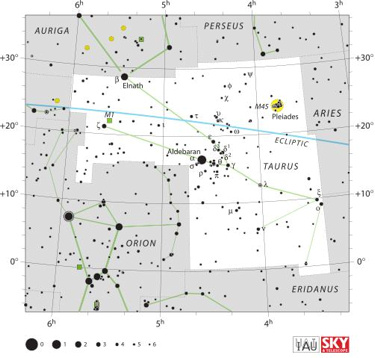
How to find it
The constellation Taurus the Bull is home to the two brightest star clusters in all the heavens, the Hyades and the Pleiades. Both are easily visible to the unaided eye. With the exception of the Ursa Major Moving Cluster, the Hyades cluster is the closest star cluster to Earth, at a distance of 150 light-years. This is about one-third the distance to the Pleiades cluster at some 430 light-years away.

Orion's Belt (lower left) points to the constellation Taurus the Bull
The Hyades cluster is easy to find by using Orion’s Belt, a compact line of three blue-white stars in the constellation Orion the Hunter. Draw a line westward (or right) through these Belt stars to find the bright ruddy star Aldebaran, the Bull’s glaring eye. Aldebaran caps the V-shape formation of stars that etches in the Bull’s face. Although Aldebaran isn’t a member of the Hyades cluster, this bright star is a great guide to this cluster that lies about 2.5 times farther off than Aldebaran. Aldebaran is only about 65 light-years distant.
Click here for a larger version of the Taurus chart
The V-shape figurine of stars (except Aldebaran) highlights the brightest of the Hyades’ few hundred stars. A dozen or more Hyades stars are visible to the unaided eye in a dark country sky, but several dozen of the cluster’s stars can be resolved through binoculars or low power in a telescope. From the northern hemisphere, the Hyades are best seen in the evening sky in winter and spring.
History and Star Lore
According to sky lore, the teary Hyades are the daughters of Atlas and Aethra, who are forever crying for their brother Hyas, who was killed by a lion or a boar. The Hyades are the half sisters to the Pleiades, the daughters of Atlas and Pleione. The gods purposely kept Atlas’ daughters – the Hyades and the Pleaides – out of reach of Orion, giving them a safe haven from his lustful pursuits.
The gods transformed Hyas into the constellation Aquarius, and the lion that killed him into the constellation Leo. The gods placed Aquarius and Leo on opposite sides of the sky for Hyas’ protection. That’s why Aquarius and Leo do not appear in the same sky together. As one constellation sets in the west, the other rises in the east – and vice versa.
Science
Although the Hyades and Pleaides are half sisters in mythology, science dosen’t find a close relationship between these two star clusters. Astronomers find that the Pleiades are composed of hot blue-white suns in the heyday of youth, which puts the age of the cluster at about 100 million years. In contrast, the cooler red giant and white dwarf stars found in the Hyades indicate a vastly older cluster over 700 million years old.
Interestingly, astronomers suspect an actual kinship between the Hyades cluster and the Beehive cluster in the constellation Cancer the Crab. Even though these two star clusters are separated from one another by hundreds of light-years, they are akin in age and travel in a similar direction in space. Astronomers believe these clusters might have originiated from the same gaseous nebula some 700 to 800 million years ago.
Photo Credit: Unishot


















